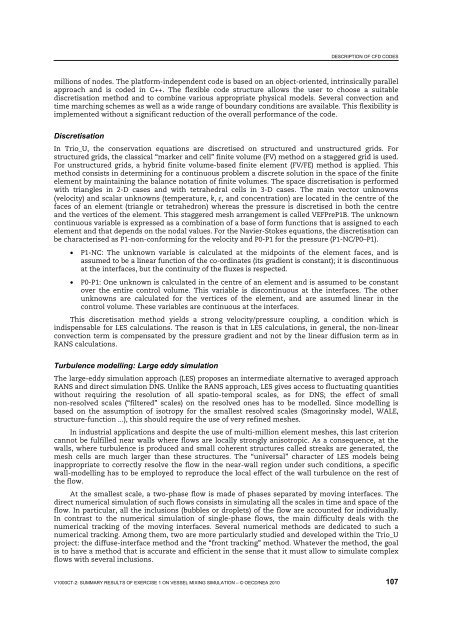VVER-1000 Coolant Transient Benchmark - OECD Nuclear Energy ...
VVER-1000 Coolant Transient Benchmark - OECD Nuclear Energy ...
VVER-1000 Coolant Transient Benchmark - OECD Nuclear Energy ...
Create successful ePaper yourself
Turn your PDF publications into a flip-book with our unique Google optimized e-Paper software.
DESCRIPTION OF CFD CODES<br />
millions of nodes. The platform-independent code is based on an object-oriented, intrinsically parallel<br />
approach and is coded in C++. The flexible code structure allows the user to choose a suitable<br />
discretisation method and to combine various appropriate physical models. Several convection and<br />
time marching schemes as well as a wide range of boundary conditions are available. This flexibility is<br />
implemented without a significant reduction of the overall performance of the code.<br />
Discretisation<br />
In Trio_U, the conservation equations are discretised on structured and unstructured grids. For<br />
structured grids, the classical “marker and cell” finite volume (FV) method on a staggered grid is used.<br />
For unstructured grids, a hybrid finite volume-based finite element (FV/FE) method is applied. This<br />
method consists in determining for a continuous problem a discrete solution in the space of the finite<br />
element by maintaining the balance notation of finite volumes. The space discretisation is performed<br />
with triangles in 2-D cases and with tetrahedral cells in 3-D cases. The main vector unknowns<br />
(velocity) and scalar unknowns (temperature, k, ε, and concentration) are located in the centre of the<br />
faces of an element (triangle or tetrahedron) whereas the pressure is discretised in both the centre<br />
and the vertices of the element. This staggered mesh arrangement is called VEFPreP1B. The unknown<br />
continuous variable is expressed as a combination of a base of form functions that is assigned to each<br />
element and that depends on the nodal values. For the Navier-Stokes equations, the discretisation can<br />
be characterised as P1-non-conforming for the velocity and P0-P1 for the pressure (P1-NC/P0–P1).<br />
• P1-NC: The unknown variable is calculated at the midpoints of the element faces, and is<br />
assumed to be a linear function of the co-ordinates (its gradient is constant); it is discontinuous<br />
at the interfaces, but the continuity of the fluxes is respected.<br />
• P0-P1: One unknown is calculated in the centre of an element and is assumed to be constant<br />
over the entire control volume. This variable is discontinuous at the interfaces. The other<br />
unknowns are calculated for the vertices of the element, and are assumed linear in the<br />
control volume. These variables are continuous at the interfaces.<br />
This discretisation method yields a strong velocity/pressure coupling, a condition which is<br />
indispensable for LES calculations. The reason is that in LES calculations, in general, the non-linear<br />
convection term is compensated by the pressure gradient and not by the linear diffusion term as in<br />
RANS calculations.<br />
Turbulence modelling: Large eddy simulation<br />
The large-eddy simulation approach (LES) proposes an intermediate alternative to averaged approach<br />
RANS and direct simulation DNS. Unlike the RANS approach, LES gives access to fluctuating quantities<br />
without requiring the resolution of all spatio-temporal scales, as for DNS; the effect of small<br />
non-resolved scales (“filtered” scales) on the resolved ones has to be modelled. Since modelling is<br />
based on the assumption of isotropy for the smallest resolved scales (Smagorinsky model, WALE,<br />
structure-function ...), this should require the use of very refined meshes.<br />
In industrial applications and despite the use of multi-million element meshes, this last criterion<br />
cannot be fulfilled near walls where flows are locally strongly anisotropic. As a consequence, at the<br />
walls, where turbulence is produced and small coherent structures called streaks are generated, the<br />
mesh cells are much larger than these structures. The “universal” character of LES models being<br />
inappropriate to correctly resolve the flow in the near-wall region under such conditions, a specific<br />
wall-modelling has to be employed to reproduce the local effect of the wall turbulence on the rest of<br />
the flow.<br />
At the smallest scale, a two-phase flow is made of phases separated by moving interfaces. The<br />
direct numerical simulation of such flows consists in simulating all the scales in time and space of the<br />
flow. In particular, all the inclusions (bubbles or droplets) of the flow are accounted for individually.<br />
In contrast to the numerical simulation of single-phase flows, the main difficulty deals with the<br />
numerical tracking of the moving interfaces. Several numerical methods are dedicated to such a<br />
numerical tracking. Among them, two are more particularly studied and developed within the Trio_U<br />
project: the diffuse-interface method and the “front tracking” method. Whatever the method, the goal<br />
is to have a method that is accurate and efficient in the sense that it must allow to simulate complex<br />
flows with several inclusions.<br />
V<strong>1000</strong>CT-2: SUMMARY RESULTS OF EXERCISE 1 ON VESSEL MIXING SIMULATION – © <strong>OECD</strong>/NEA 2010 107

















